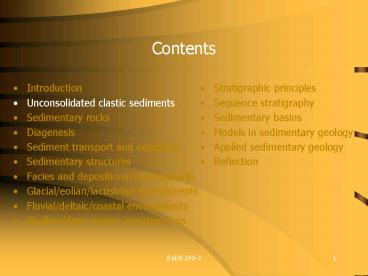Contents - PowerPoint PPT Presentation
1 / 27
Title: Contents
1
Contents
- Introduction
- Unconsolidated clastic sediments
- Sedimentary rocks
- Diagenesis
- Sediment transport and deposition
- Sedimentary structures
- Facies and depositional environments
- Glacial/eolian/lacustrine environments
- Fluvial/deltaic/coastal environments
- Shallow/deep marine environments
- Stratigraphic principles
- Sequence stratigraphy
- Sedimentary basins
- Models in sedimentary geology
- Applied sedimentary geology
- Reflection
2
Unconsolidated clastic sediments
- Particles (or clasts) are the basic elements of
any sediment - Clastic (terrigenous clastic or siliciclastic)
sediments (80-85 of the stratigraphic record)
consist of particles derived from pre-existing
rocks, as opposed to non-clastic sediments - Texture
- Grain (particle) size
- Grain shape
- Clast/matrix relationships
- Fabric
- Lithology is the general characterization of a
sediment or a sedimentary rock (e.g., coarse
sand, mudstone)
3
Unconsolidated clastic sediments
- The Udden-Wentworth grain-size scale is based on
factors of two ? -log2 (mm) - Mud (lt63 ?m gt4 ?)
- Clay (lt4 ?m gt8 ?)
- Silt (463 ?m 48 ?)
- Sand (632000 ?m -14 ?)
- Gravel (gt2000 ?m lt-1 ?)
- Grain-size (particle-size, granulometric)
analysis - The old-fashioned way direct measurement
(gravel) and sieve/pipette analysis (sand and
mud) - The modern technology laser particle sizing
(sand and mud)
4
(No Transcript)
5
Unconsolidated clastic sediments
- The Udden-Wentworth grain-size scale is based on
factors of two ? -log2 (mm) - Mud (lt63 ?m gt4 ?)
- Clay (lt4 ?m gt8 ?)
- Silt (463 ?m 48 ?)
- Sand (632000 ?m -14 ?)
- Gravel (gt2000 ?m lt-1 ?)
- Grain-size (particle-size, granulometric)
analysis - The old-fashioned way direct measurement
(gravel) and sieve/pipette analysis (sand and
mud) - The modern technology laser particle sizing
(sand and mud)
6
(No Transcript)
7
(No Transcript)
8
Unconsolidated clastic sediments
- Moment measures
- First moment mean (cf. median, mode)
- Premier measure of the grain size
- Second moment variance (cf. standard deviation)
- Measure of the degree of sorting
- (? standard deviation)
- Third moment skewness
- Measure of the symmetry of the grain-size
distribution
9
(No Transcript)
10
(No Transcript)
11
(No Transcript)
12
(No Transcript)
13
(No Transcript)
14
(No Transcript)
15
Unconsolidated clastic sediments
- Grain shape
- Roundness (well rounded to very angular)
- Sphericity (high or low)
- Clast/matrix proportion
- The matrix is the relatively fine-grained
material that lies between the relatively
coarse-grained clasts - Clast-supported sediments (clasts are in direct
contact) - Matrix-supported sediments (clasts are entirely
surrounded by matrix) - Fabric
- Preferential orientation of particles in a
sediment or tendency of a rock to break in
specific directions
16
Unconsolidated clastic sediments
- Sediment composition
- Detrital mineral grains (quartz, feldspar, mica,
heavy minerals) - Lithic fragments (polymineral grains or rock
fragments) - Detrital mineral grains dominate in silts, lithic
fragments dominate in gravels - Sediment maturity (degree of change compared to
original bedrock provides evidence on the
history of a sediment) - Textural (mud content, sorting, grain shape)
- Mineralogical (proportion of stable or resistant
minerals) - Pitfalls! (depends strongly on the nature of the
original bedrock)
17
(No Transcript)
18
(No Transcript)
19
Unconsolidated clastic sediments
- Sediment composition
- Detrital mineral grains (quartz, feldspar, mica,
heavy minerals) - Lithic fragments (polymineral grains or rock
fragments) - Detrital mineral grains dominate in silts, lithic
fragments dominate in gravels - Sediment maturity (degree of change compared to
original bedrock provides evidence on the
history of a sediment) - Textural (mud content, sorting, grain shape)
- Mineralogical (proportion of stable or resistant
minerals) - Pitfalls! (depends strongly on the nature of the
original bedrock)
20
(No Transcript)
21
(No Transcript)
22
Unconsolidated clastic sediments
- Clay minerals
- Clay minerals are phyllosilicates with layered
crystal structures - Kandite group (two layers) kaolinite
- Smectite group (three layers) montmorillonite,
illite, chlorite - Key physical and chemical characteristics of clay
minerals - Platy shape (easy to keep in suspension, very
slow settling rates) - Strong cohesion due to electrostatic charge
(relatively difficult to erode, tendency to
flocculate)
23
(No Transcript)
24
(No Transcript)
25
(No Transcript)
26
(No Transcript)
27
Unconsolidated clastic sediments
- Clay minerals
- Clay minerals are phyllosilicates with layered
crystal structures - Kandite group (two layers) kaolinite
- Smectite group (three layers) montmorillonite,
illite, chlorite - Key physical and chemical characteristics of clay
minerals - Platy shape (easy to keep in suspension, very
slow settling rates) - Strong cohesion due to electrostatic charge
(relatively difficult to erode, tendency to
flocculate)































![Top Content Writing Agencies in India 2022 [Updated 2022] PowerPoint PPT Presentation](https://s3.amazonaws.com/images.powershow.com/9707624.th0.jpg?_=20220110052)